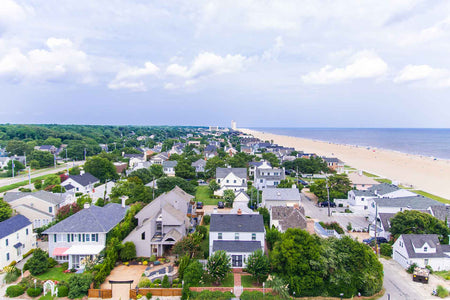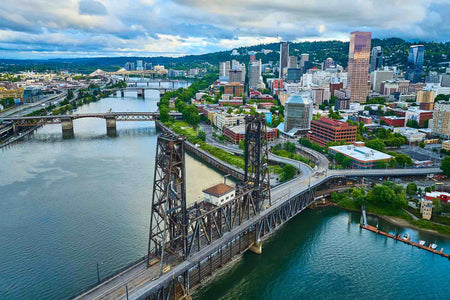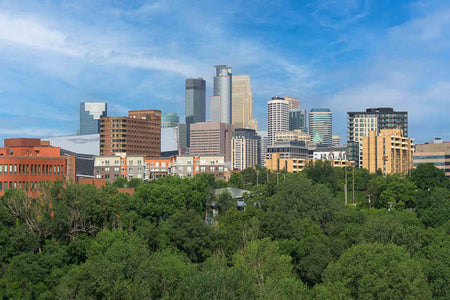- Allergy season in Utah begins in February and typically ends after the first hard frost in late October or November. The peak allergy months are April, May, and September.
- The main allergens include tree pollen from February to May, grass pollen from May to July, and weed pollen from July until the first frost.
- To manage symptoms, it is important to track pollen levels, take medications, keep windows closed, and use HEPA air purifiers to reduce exposure.
Utah is known for its stunning red rock canyons, snowy mountain peaks, and wide-open deserts. But did you know it’s also a place where seasonal allergies can be a big problem? That’s because Utah has a dry climate and a mix of plants that release pollen at different times of the year.
If you have allergic rhinitis (also called hay fever), you might feel it more during allergy season in Utah. But don’t worry — knowing what to expect can help you prepare.
This article will cover when allergy season starts and ends, the most common allergens to watch out for, and how you can protect yourself from bothersome symptoms.
When Does Allergy Season Start in Utah?
Allergy season in Utah usually starts in February when trees begin releasing pollen. Since Utah has a dry climate, pollen stays in the air longer, making allergies worse. Wind and warm weather can spread pollen even more, which leads to sneezing, itchy eyes, and other allergy symptoms for many people [*].
Tree Pollen (Feb to May)
In Utah, tree pollen season usually lasts from February to May, when many trees start releasing pollen into the air. This early allergy season can be tough for people who are sensitive to pollen because tree pollen is one of the strongest allergens [*].
Some common trees in Utah that cause allergies include maple, poplar, ash, cottonwood, birch, walnut, juniper, acacia, mesquite, alder, box elder, mulberry, sycamore, elm, cypress, oak, and cedar.
If you're allergic to tree pollen, you might experience sneezing, a stuffy nose, itchy eyes, and trouble breathing during the spring months.
Grass Pollen (May to July)
When tree pollen levels go down, grass pollen season in Utah starts. It is usually worst between May and July and can cause allergy symptoms for many people.
Some of the most common grasses that cause allergies are Bermuda grass, meadow fescue, brome, orchard grass, wild oat, timothy, red top, Johnson grass, and rye. These grasses can be found in lawns, parks, fields, roadsides, and pastures throughout Utah.
Weed (July to Frost)
Weed pollen season in Utah starts in July and lasts until the first hard frost, usually in late October or November. This makes it the longest allergy season of the year.
Some common weeds that cause allergies include ragweed, pigweed, sagebrush, tumbleweed, and lamb’s quarter.
What are the Worst Months for Allergies in Utah?
The worst months for allergies in Utah are April, May, and September.
In April and May, tree and grass pollen fill the air, causing sneezing, stuffy noses, and itchy eyes for many people.
By September, weed pollen — especially from ragweed and sagebrush — becomes the biggest problem, making late summer and early fall tough for allergy sufferers [*].
Utah’s dry, windy weather also makes things worse by keeping pollen in the air longer.
When Does Allergy Season End in Utah?
Allergy season in Utah usually ends when the first big freeze happens, around late October or November.
Until then, weed pollen — especially from ragweed and sagebrush — can still cause sneezing, stuffy noses, and itchy eyes.
Once the weather gets really cold, pollen levels drop, and allergy symptoms get better.
However, things like dust mites and mold inside homes can still cause allergies all year.
Common Allergens in Utah
Utah has a variety of plants that release pollen throughout the year. However, not everyone reacts to the same allergens, and factors like weather, air quality, and local plant life can affect pollen levels.
Below are some of the most common trees, grasses, and weeds that cause allergies in Utah.
Tree pollen:
- Maple
- Popler
- Ash
- Cottonwood
- Birch
- Walnut
- Juniper
- Acacia
- Mesquite
- Alder
- Box Elder
- Mulberry
- Sycamore
- Elm
- Cypress
- Oak
- Maple
- Cedar
Grass pollen:
- Bermuda
- Meadow
- Fescue
- Brome
- Orchard
- Wild oat
- Timothy
- Red top
- Johnson grass
- Ryegrass
Weed pollen:
- Ragweed
- False ragweed
- Pigweed
- Careless weed
- Sagebrush
- Tumbleweed
- Cocklebur
- Yellow dock
- Marsh elder
- Lamb’s quarter
How to Prepare for Utah Allergy Season
If you suffer from seasonal allergies in Utah, taking the right precautions can help reduce your symptoms and make allergy season more manageable. Simple habits like monitoring pollen levels, keeping your home clean, and protecting yourself outdoors can make a big difference.
Follow these tips:
- Track pollen levels: Check daily pollen forecasts and limit outdoor activities when counts are high.
- Start medications early: Using antihistamines or nasal sprays before allergy season gets intense can help reduce symptoms.
- Clean regularly: Dust and vacuum frequently using a HEPA filter vacuum to reduce indoor allergens.
- Keep windows closed: Prevent pollen from entering your home by keeping windows shut, especially during windy days.
- Use air purifiers: Running an air purifier with a HEPA filter in your home and car can help trap pollen, dust, and other airborne allergens, creating a cleaner indoor environment.
- Shower and change clothes after being outdoors: Rinse off pollen from skin and hair to avoid bringing it indoors.
- Wear sunglasses and hats: Protect your eyes and face from airborne pollen when spending time outside.
- Avoid hanging laundry outdoors: Pollen can stick to clothes, sheets, and towels while they dry outside. When you bring them indoors, you may unknowingly carry allergens into your home.
- Avoid mowing and gardening: These activities stir up pollen and other allergens, increasing exposure. If you must do yard work, wear a pollen mask, and shower and change clothes immediately after working outside.
The Bottom Line
Since pollen levels in Utah vary throughout the year, staying informed about peak seasons and common allergens is key.
Simple habits like keeping windows closed, using air purifiers, using a nasal spray, and washing off pollen after being outside can really help. A few smart habits can help you enjoy Utah’s beauty without the sneezing and itching.
References:
- Environmental allergies. (2024, November 26). University of Utah Health | University of Utah Health. https://healthcare.utah.edu/dermatology/programs/allergy-asthma/environmental
- Tree pollen allergy | AAFA.org. (2025, February 27). Asthma & Allergy Foundation of America. https://aafa.org/allergies/types-of-allergies/pollen-allergy/tree-pollen-allergy/
- Strand, H. (2020, July 18). Wind and Sagebrush. Wild About Utah. https://wildaboututah.org/wind-and-sagebrush/









